1983 South African Grand Prix race report
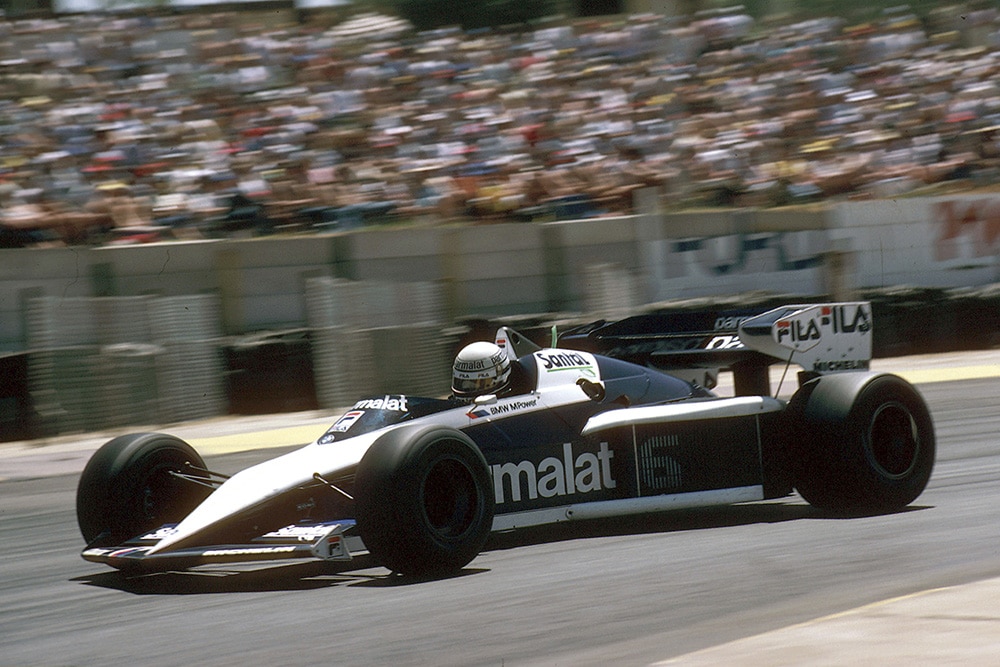
Brabham's Riccardo Patrese took his second career win
Motorsport Images
A Clean Sweep by Brabham
Kyalami, Johannesburg, October 15th
Under normal conditions the South African GP takes place at the beginning of the season and when the 1983 season was originally planned it was thus, but the agreed change in the Formula One rules that outlawed sliding side skirts and under-car aerodynamics for 1983 meant that there was a dire shortage of time before the South African race was due. Consequently an agreement was made with the South African organisers to reschedule their race to the end of the season, thus giving the teams an extra month to modify and test their existing cars, or to build new ones. As a result, the race at Kyalami held on Saturday, October 15th in very hot weather conditions, as the South African summer was fast approaching, saw the South African GP close the 1983 Grand Prix season, the original list of seventeen races being reduced to fourteen with the cancellation of the Swiss GP, the New York GP and the Las Vegas GP.
This reshuffle of the calendar meant that the season ended on a high note in more ways than one, for apart from the Kyalami circuit, north of Johannesburg being 6,000 feet or so above seal level, it is also a very fast circuit and a good test of car and driver. The previous two seasons ended on the lowest possible note, and in fact, fizzled out undramatically in the car park of a Las Vegas Hotel, on which a “Mickey-Mouse” circuit had been laid out with concrete blocks. The Kyalami circuit is laid out on an open hillside, not as spectacular as the Osterreichring, but a fine circuit nonetheless, with an ultra fast downhill straight, followed by one of the best corners in Formula One racing as the cars plunge downhill on a falling away right-hand bend followed by an uphill left-hander that calls for a car to be well-mannered and well-balanced to make the most of the right-to-left flick at about 160 mph. The circuit then winds along the hillside in a series of bends that end in a rush up to a fast climbing right-hand hairpin that leads onto the top straight, with a fast right-hander before the pits and the brow of the hill by the start / finish line and the subsequent plunge down the ultra-fast straight.
With a lap record of over 216 kph (134 mph) it is not a circuit for the faint-hearted or a car with a weak engine. The keynote of setting-up a car for the circuit is to strike a usable compromise between maximum speed, achieved by “feathering” all the aerodynamic aids, and “down-force”, to aid cornering on the fast bends. On some circuits you can afford to lose some maximum speed by increasing the aerofoil angles, and benefit on lap times by superior cornering speeds aided by aerodynamic “down-force”, but at Kyalami the balance between the two is very critical because you are at maximum speed for a long time so that you cannot afford to sacrifice too much on maximum speed. Even so, McLaren, Brabham and Renault were all using their large Ferrari-style “tea-tray” rear aerofoils as first seen at Brands Hatch recently, while Ferrari and ATS have been using them all season.
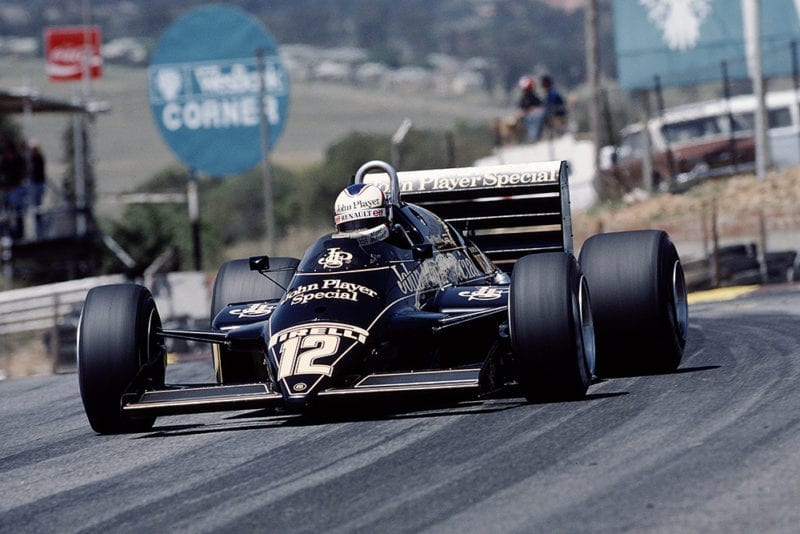
Nigel Mansell started 7th for Lotus
© Motorsport Images
When the South African race is at the beginning of the season all the top teams go out there early to do a lot of testing under ideal conditions, apart from the altitude which affects power output from engine, especially normally aspirated ones. There was an early exodus from Europe to make use of testing time, so that when official practice began on Thursday morning mot drivers knew where they were going, how they were going and why.
Being the last race of the season there were a number of important things at stake, not least the destination of the 1983 World Drivers’ Championship and next year’s number 1. The real issue lay between Alain Prost (Renault) and Nelson Piquet (Brabham-BMW) with Rene Arnoux (Ferrari) in with a chance. The Manufacturers’ Championship was a foregone conclusion for Ferrari for the second year running. These things were of the moment, but there were equally important things for the future. It was to be Patrick Tambay’s last race for the Scuderia Ferrari as he had politely been served his notice and Michele Alboreto had been nominated for the team in 1984. It was the first appearance of the new Williams FW09 powered by the turbo-charged V6 Honda engine which the Spirit team have been racing with since mid-season, and have now lost, the Japanese firm putting all its efforts into the proven team from Didcot with 1982 World Champion Keijo Rosberg as their number one driver. It was the last chance for the McLaren team to measure up their interim car with the Porsche V6 turbo-charged engine against the opposition before starting on its new car for 1984, and the Brabham team were out for a hat-trick of wins, following Piquet’s victories at Monza and Brands Hatch with Gordon Murray’s sleek car powered by the BMW factory’s best 4-cylinder turbocharged engine. The South African GP had everything going for it.
Qualifying
Tambay’s task during the two day test period before official practice was tyre testing, while Arnoux was left to get on with a programme of engine development, including trials with different turbochargers and boost control valve springs. Now Arnoux, whatever else he’s been described as, has never been considered a good test driver and Mauro Forghieri’s exasperation built up steadily during the two day period. After running each new turbocharger, Arnoux would return to the pits and say “yes, very nice,” or words to that effect, but fail to provide Forghieri with many worthwhile, and specific comments. “I need to know more than that,” said the engineer eventually. “Well, it doesn’t pull enough revs in fifth,” replied Rene analytically. “In that case perhaps you would like me to put second where fifth is in the gearbox,” suggested Forghieri acidly, “that way you’ll be able to pull plenty of revs at the top end!” Thus ended this unproductive exchange!
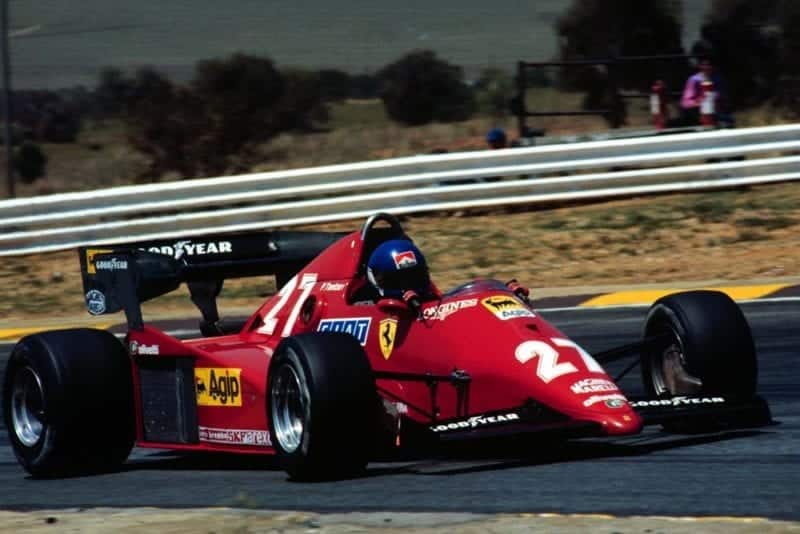
Ferrari’s Patrick Tambay started the race on pole
© Motorsport Images
Tambay’s exclusion from the 1984 Ferrari team had nothing to do with his ability, it was entirely a question of internal politics Within the Ferrari empire and poor Tambay was the scapegoat. Instead of sulking and dragging his feet in his last race for the scuderia, as some drivers have done in the past, he was on terrific form and made fastest lap in both qualifying sessions to put his red Ferrari on pole position on the grid, but only two-tenths of a second slower was Nelson Piquet, these two being in a class of their own.
Tambay did three quick runs in Thursday’s qualifying, squeezing a 1m 6.8s best out of his second set of Goodyear tyres. He then lost pole briefly as Nelson Piquet’s scorched round in 1m 6.7s in his Michelin-shod Brabham but came back with a 1m 6.554s, using the best surviving tyres from his first two runs in the Ferrari, which threw pole position beyond reach. The weather was significantly hotter on Friday and, although ten drivers improved their times on the second day, both Tambay and Piquet were firmly ensconced on the front row thanks to their Thursday efforts. For the Friday session, Tambay chose to do only a single quick run on one set of qualifying tyres: for the remainder of the hour he simply sat in his Ferrari, helmet on, shaded by a large umbrella, waiting to see whether Piquet’s herculean efforts would jeopardise his pole position, but the Brabham-BMW driver failed to take pole position, though he was the only person to crack 1m 7s during that final hour.
By contrast, Rene Amoux was having a foul time. On Thursday afternoon his C3 rolled to a halt with a minor electrical problem on the approach to Leeukop, and after he climbed out, the marshals inadvertently pushed the car over his right foot as they moved it out of the way! Amoux, almost sick with pain, hobbled back to the pits where his foot was bathed and examined by the circuit doctor. Mercifully, he had got away with only serious bruising and no bones were broken: nonetheless, this little drama was to make life pretty uncomfortable for him for him for the rest of the weekend. It’s thus to his credit that he rose splendidly to the occasion on Friday and took his C3 round in 1m 7.105s to snatch fourth place on the grid behind Riccardo Patrese’s Brabham BT52B. Patrese and Arnoux were in row two and then came Prost and Rosberg.
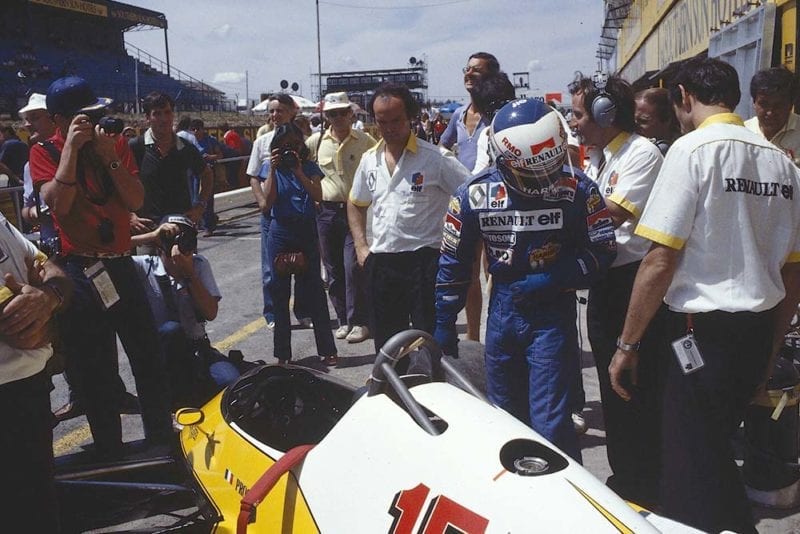
Alain Prost’s Renault is prepared in the pits
Motorsport Images
The placing of the first Williams-Honda V6 t/c in sixth position on the grid was one of the most significant happenings in practice and it was backed up by Laffite putting the second Williams-Honda V6 in tenth place, Mansell (Lotus-Renault), Winkelhock ATS-BMW) and de Cessna (Alfa Romeo) separating the two new cars from Didcot, which was impressive by any standards. For Rosberg to be as high as he was came as no surprise, for he has been driving brilliantly all season with the obsolete Cosworth-powered Williams FW08C and now with an engine the equal of the opposition he was in with the best. Jacques Laffite failed to qualify his Cosworth-powered Williams for the last two races which puzzled those who support him, but given the tools he can still get the job done. The whole performance of the Williams team has put the Honda V6 engine into perspective for recent races by Johansson with the same engine in a Gordon Coppuck-designed Spirit chassis have not been world-shattering, though there have been moments to suggest that the Japanese V6 engine could not be ignored. It would >now appear that it is a force to be reckoned with by everyone in Formula One.
A distinctively different profile on the circuit is presented by this new FW09, although few would question that it is very definitely typically Williams in appearance. Its chassis is uncomplicated and constructed from honeycomb alloy sheeting, Patrick Head only employing carbon fibre composite to cover the central fuel cell. Although the Honda contract with the Spirit team included the South African event, the team decided to cut its losses and miss the Kyalami race, making use of the time to progress with plans for 1984. Another team who gave the South African race a miss was the rather shaky little Theodore team, the Ensign part of the business having pulled out with Morris Nunn doing other things and engineer Nigel Bennett joining the Lola factory. This meant that Roberto Guerrero and Johnny Cecotto had nothing to drive and it also meant that only twenty-six cars were entered for the race so everyone was assured of a place on the starting grid and Kenny Acheson in the John MacDonald March-Cosworth V8 was able to start his first Grand Prix. The two Osellas were at first posted as non-starters by the rule that requires everyone to lap within 110% of the fastest man but by mutual agreement of all the other teams this rule was waived and Fabi and Ghinzani were allowed to take the last two places on the grid.
The Brabham camp was in a confident mood by the end of qualifying, its sleek BT52Bs occupying second and third positions on the grid. Both cars sported only minor revisions to their oil cooling systems, but were otherwise turned out to the specification which was used to win at Monza and Brands Hatch. On Thursday morning each car had suffered an engine failure, and during first qualifying Patrese’s mount suffered a turbo failure while he was on his quickest lap. The failure occurred as he came through the fast right hand lank just before the pits, but he still managed a 1 min 8.181 sec on his second set of Michelins. In an attempt to improve on that situation, he hopped into the spare car and tried to squeeze another quick lap out of the same set. But they were finished and he had to wait until the following day before returning his 1 min 7.001s best after an over-zealous performance which saw the Italian’s BT52B getting all four wheels on the grass at the fast downhill Barbecue comer.
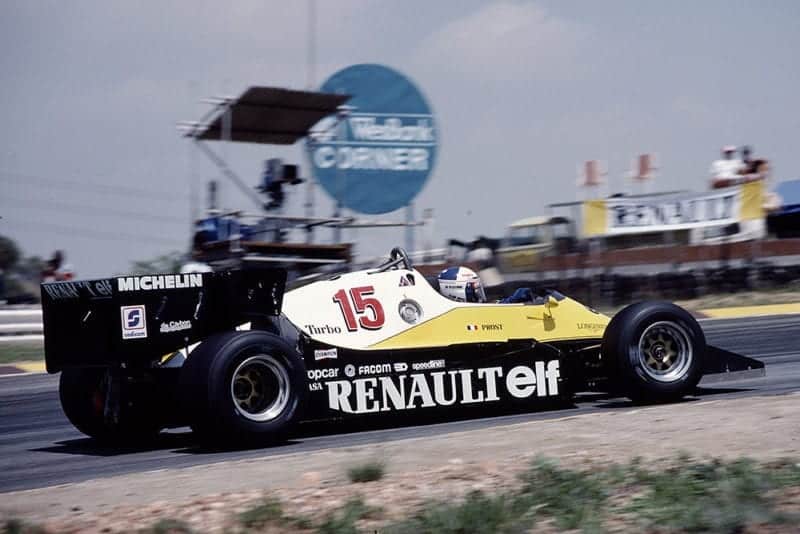
Once on track, Prost secured 5th on the grid
© Motorsport Images
Renault on the other hand were nothing like as confident, even though for the first time they had brought along a set of special engines designed to accept more turbo boost pressure during qualifying. They also had a total of four RE40s available for Championship points leader Alain Prost (RE40 / 05 and 06) and his team-mate Eddie Cheever (RE40 / 04 and 03). The American tried one of the qualifying engines during untimed practice on Thursday morning, but it suffered a turbo failure and, when a new turbo was fitted for first qualifying, Eddie found it was about 400 rpm down at the top end. Prost found the race engine fitted in his RE40 was “nothing special”, but admitted with great satisfaction that the car’s handling was absolutely perfect.
The McLaren team hoped that revisions to the Porsche-built TAG turbo engine would eliminate the valve gear problems that have plagued this new engine during its first three races. They had a third MP4 1E on hand as team spare for the first time, and although this was pressed into action for Watson on race day, Niki Lauda had a generally trouble-free time in practice.
With McLaren and Williams now firmly ensconced within the ranks of turbo competitors, it came as little surprise to find Michele Alboreto’s Tyrrell 012 heading the list of non-turbo runners. Alboreto, currently looking forward to his somewhat controversial appointment as Rene Arnoux’s partner in the ’84 Ferrari line-up, set his best time of 1 min 11.096 sec on Thursday and, when he found he couldn’t stay in team-mate Danny Sullivan’s slipstream the following day, he took over the American’s car for the final session, but he couldn’t improve on his Friday best.
If it had been warm on Friday, then it was a South African Spring scorcher on Saturday with hardly a cloud in the sky and none of those ominous thunderstorms, which so frequently jeopardise proceedings when the race takes place earlier in the season. In order to keep Kyalami’s narrow and outdated pit facilities as free as possible for cars to make their pit stops, it was decided that the Toleman and ATS teams should set up their refuelling facilities on the wider apron below the start / finish tower before the line of pits. There was a lot of bad feeling, general lack of organisation and flaring tempers as various officials attempted to clear the pits of superfluous individuals.
Race
In the morning warm-up session before the race, in which everyone runs in full race trim, Lauda recorded the fastest lap with his McLaren-Porsche V6, which did not go unnoticed by the other teams.
This very hot weather effectively spelt finis to the hopes of the Goodyear-shod runners at Kyalami, such conditions favouring Michelin’s radials. The first positive indication of this came in the morning warm-up session in which Niki Lauda’s McLaren-Porsche turned a very impressive 1 min 9.504 sec on race tyres and almost full fuel load. Patrese, Piquet and Prost were next up, with Goodyear’s best runner, Tambay’s Ferrari, some 1.2 sec slower than Lauda. Watson was still suffering engine problems in his McLaren, the newly installed V6 still demonstrating a mysterious loss of power at the top end, an it was decided that he would start in the spare MP4 1E. Winkelhock’s ATS flew off the road at Crowthorne after a rear suspension failure, while the Williams lads had their work cut out replacing the failed Honda V6 in Rosberg’s car in the two and a half hours available between the end of the warm-up and the start of the race. Sometimes an unlikely or insignificant driver or car makes a fast time in the race-day warm-up and it is not important, but Niki Lauda can never be overlooked, nor can Porsche.
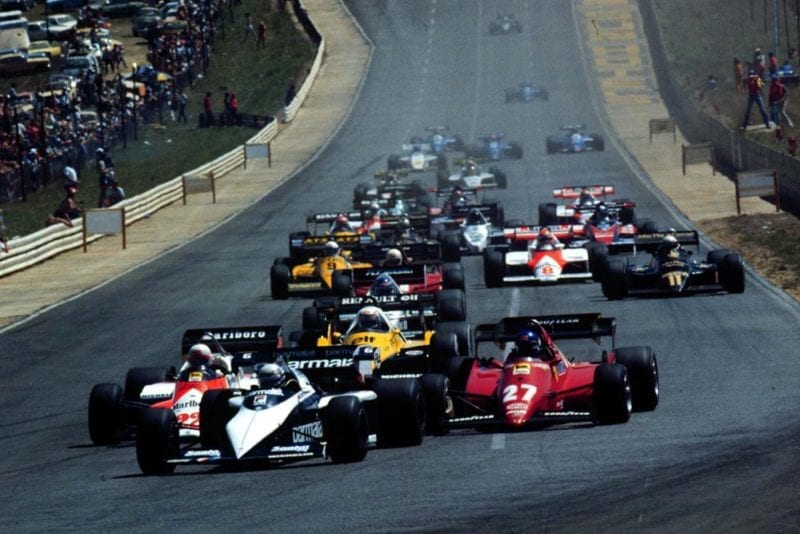
Patrese leads the pack – team-mate Nelson Piquet is already out of shot
Motorsport Images
From the moment the green light came on Piquet had it all his own way, his start was exemplary and he really gave it all he’d got in the opening laps, pulling out an enormous lead even on the first lap. There was little doubt that you needed to be on Michelin tyres for this race for the dust of the start had barely subsided before the two Brabhams took charge with Tambay unable to match their speed, nor that of Prost in the Renault, de Cesaris (Alfa Romeo) and Lauda (McLaren) who had rocketed through from the sixth row.
His team-mate Watson in the second McLaren-Porsche was left behind as the grid moved off on the parade-lap and though he was push-started he retook his place in she parade thus infringing the rule forbidding overtaking by anyone once the parade-lap has begun. He was black-flagged and disqualified on lap 18. Piquet simply drove away from everyone, so much so that when he made his routine pit-stop for new tyres and more petrol, he rejoined the race just as his team-mate came into view and continued to lead the race even while on his standing-start lap from the pit-lane. The Brabham mechanics did a superb job in getting him out in 12 seconds, even though the television count-down made it 9.2 sec. From the very start of the race neither Prost nor Amoux were any challenge at all to Nelson Piquet and indeed they barely figured in the race as such, let alone as challengers for the outcome of the World Championship points-scoring game. Arnoux had never figured among the front runners from the start, his Goodyear tyres demoralising him until he gave up when his Ferrari engine overheated, while Prost was taken aback by being passed with ease by Lauda in the McLaren-Porsche and when the unhappy little Frenchman arrived in the pit lane it was not for petrol and tyres, but to retire from the fray with “turbo-charger trouble” to quote the Renault team.
Apart from Piquet’s domination, Lauda’s progress was the big feature of the race, for after charging up from his position of twelfth on the starting grid, he got into a strong third place a few feet behind Patrese’s second-place Brabham. There was nothing he could do about the Italian, but equally Patrese could not shake him off and it was with some relief that he saw Lauda heading for the pit lane for new tyres wad petrol. As can so easily happen in these fast pit stops something can go wrong, and the right-rear wheel baulked keeping Lauda up on the jacks for more than 23 sec, but he rejoined the race at undiminished speed and set about making up the lost time, the McLaren-Porsche looking very impressive in only its fourth race. Although Tambay’s pit stop with the Ferrari went smoothly, it was slow in comparison with the Brabham team, for Patrese had been serviced in just over ten seconds, and the Ferrari lost a place to the Alfa Romeo of de Cesaris as it left the pits. Warwick had been running well in mid-field in the opening stages and as others like de Angelis (Lotus-Renault) and Laffite (Williams-Honda) retired he moved up until he was in sixth place, ahead of Cheever (Renault) and Rosberg (Williams-Honda). He moved up another place when Tambay retired, the Ferrari having run slowly for a lap with falling boost pressure before expiring out on the circuit and this put Warwick in fourth place. Team-mate Giacomelli was not so lucky, a turbo failure causing a merry little fire at the back of the car as he drew off to retire.
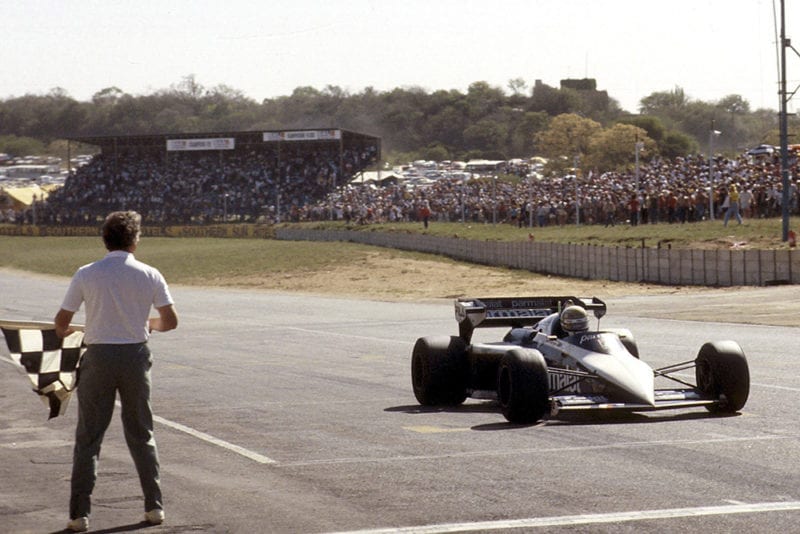
Patrese takes the chequered flag the the first time this season
© Motorsport Images
With Prost gone, Piquet had the 1983 World Championship in his grasp, but he could still lose it if the Brabham let him down or he made a mistake, for his retirement would leave Prost ahead on points, even though the Frenchman had long since retired. However, Piquet was more intent on winning the Championship than winning the race, so he eased right off and drove carefully to the finish, letting Patrese, Lauda and de Cesaris all go by for those three were still racing to win the South African GP, especially Lauda who had the bit between his teeth and was hounding Patrese once more. Fourth place was quite sufficient for Piquet to finish the season ahead of Prost on points, so he cruised round and let the others get on with the racing. With only four laps to go Lauda’s car suddenly slowed as the boost pressure dropped and he pulled off on the left of the circuit after the Clubhouse Comer, his race run and an impressive second place gone. The McLaren suffered an instant loss of power from its Porsche engine as a result of an electrical systems malfunction.
Patrese came home the winner of the South African GP, with de Cesaris in a mature second place, which was another great boost for the Euroracing Alfa Romeo team after his second place in the German GP. The wily Piquet finished third secure in the knowledge that he had won the 1983 World Championship on points rather than race victories, though his domination of the last three races has been unquestionable. A lap behind came Warwick in another good fourth place for the Toleman team, followed by Rosberg in fifth place in a very impressive debut race for the new Honda powered Williams.
In no way did the 1983 Grand Prix season fizzle out, it ended on a strong note of interest and enthusiasm for 1984. The day of the small private team has long gone and Grand Prix racing is now the province of major motor car manufacturers, using the specialist skills and knowledge of some of the small concerns. While Ferrari, Renault and Alfa Romeo are complete factory teams, with all the research and development facilities behind them that are essential to stay ahead, Brabham, Williams, McLaren and Lotus have the full backing of major factories for the supply and development of engines. BMW, Honda, Porsche and Renault are as keen for their supported teams to win as if they were their own teams. Against these giant engine manufacturers Brian Hart struggles gamely with his turbo-charged 4-cylinder in the Toleman, but it is an uphill struggle. – H.J.
Results
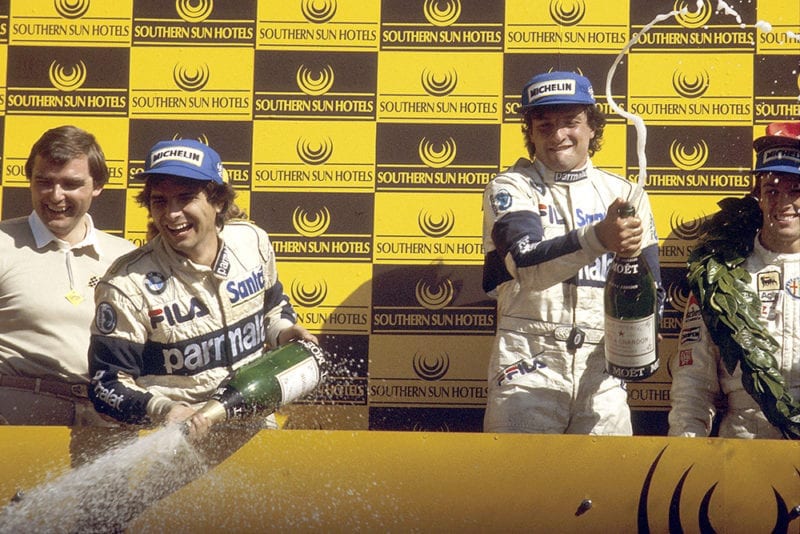
Patrese celebrates with Piquet (left) and de Cesaris (right)
© Motorsport Images
South African Grand Prix – Formula One – 77 laps – Kyalami – 4.104 kilometres per lap – 316.0 kilometres – very hot
1st: Riccardo Patrese (Brabham-BMW BT52B/6) 1 hr 33 min 25.70 sec – 202.939 kph
2nd: Andrea de Cesaris (Alfa Romeo 183T/03) 1 hr 33 min 35.027 sec
3rd: Nelson Piquet (Brabham-BMW BT52B/6) 1 hr 33 min 47.677 sec
4th: Derek Warwick (Toleman-Hart TG183B/4) 1 lap behind
5th: Keijo Rosberg (Williams-Honda FW09/01) 1 lap behind
6th: Eddie Cheever (Renault RE40/04) 1 lap behind
Fastest lap: Nelson Piquet (Brabham-BMW BT52B/6) on lap 6 in 1 min 09.948 sec – 211.219 kph
